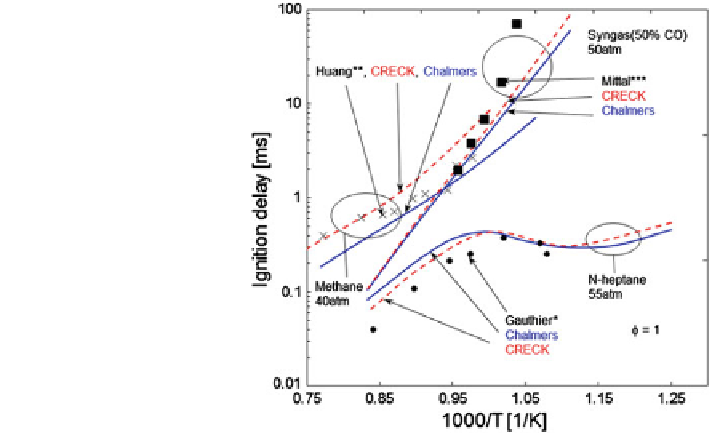Environmental Engineering Reference
In-Depth Information
Fig. 9 Predicted and
measured ignition delays for
n-heptane/air, syngas/air, and
methane-air mixtures at high
pressures and
ϕ
=1
experiments, but were not duplicated in simulations (Dryer and Chaos
2008
; Jain
et al.
2013
). It is also noteworthy that the Chambers mechanism is able to reproduce
the experimentally observed two-stage ignition process and negative temperature
coef
cient (NTC) region.
4.2 Ignition Characteristics in Dual-Fuel Diesel Engines
In a dual-fuel engine, the ignition is initiated by the pilot diesel. Since ignition
represents a critical process with regard to engine performance and emissions, it is
important to examine the ignition of pilot fuel in the presence of a combustible
gaseous fuel-air mixture. In particular, the ignition chemistry of large hydrocarbons,
such as n-heptane, is known to be characterized by the NTC (negative temperature
coef
cient) and two-stage ignition processes (Curran et al.
1998
). Previous studies
have not analyzed the effect of gaseous fuels on these processes. Therefore, sim-
ulations were performed to examine these aspects by considering homogeneous
gaseous mixtures in a constant volume reactor and two-phase mixtures in a diesel
engine. Figure
10
depicts the
first and second stage ignition processes in diesel
engine in terms of the mass pro
les of OH and QOOH with respect to crank angle
for the single- and dual-fuel cases, as listed in Table
3
. As indicated in the table, the
start of injection (SOI) is
after top dead center (ATDC), and injection duration
is 8.5 crank angle degree (CAD).
For n-heptane, the two-stage ignition process is well depicted in the
−
8
°
figure, with
the
first-stage ignition occurring at
−
4.8
°
ATDC and the second-stage at
−
2.4
°
ATDC. The
first-stage ignition is de
ned by the value of integrated heat release

Search WWH ::

Custom Search